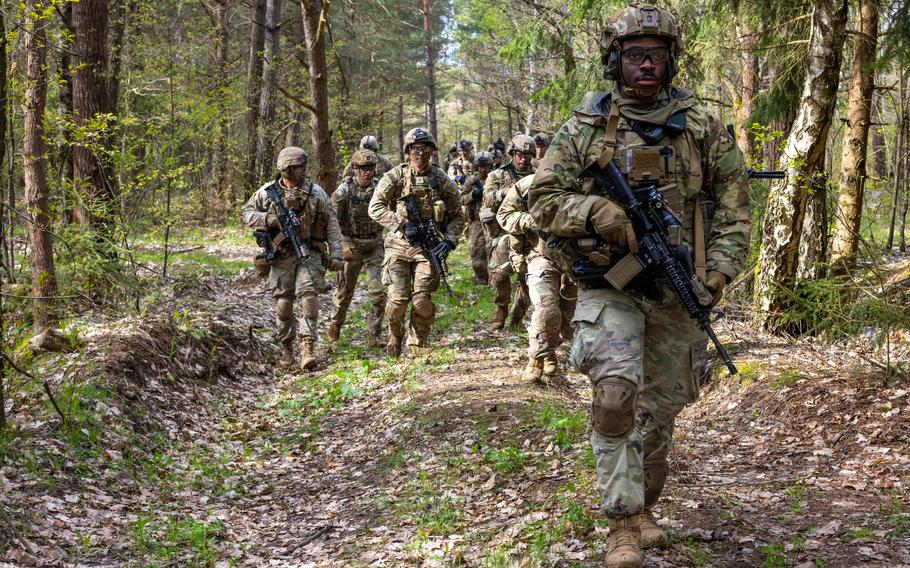
U.S. soldiers assigned to Eagle Troop, 2nd Squadron, 2nd Cavalry Regiment, walk to the range during exercise Defender 24 at Bemowo Piskie Training Ground, Poland, April 16, 2024. Army leaders recently acknowledged potential benefits and challenges of permanently basing more soldiers in Poland, noting the strain on troops from increased deployments and the high costs associated with overseas military infrastructure. (Gianna Sulger/U.S. Army)
The Army’s top leaders this week left open the possibility of basing more soldiers on a permanent basis in Poland, a move that could provide relief for units burdened with repeated deployments overseas.
“Certainly, that would have some benefits in terms of operational tempo,” Army Secretary Christine Wormuth told the House Armed Services Committee on Tuesday.
Among the challenges associated with moving an armored brigade to Poland would be getting in place overseas military construction projects such as schools and other amenities that families would need, she said.
“There are pros and cons associated with permanent basing,” Wormuth said.
The comments from the top civilian leader in the Army come after nearly a decade of frequent deployments to Europe, which picked up pace after Russian’s 2014 intervention in Ukraine. Those missions have only intensified since Moscow’s full-scale invasion two years ago.
Armored, infantry and combat aviation brigades have been at the center of that effort. But the situation has raised questions about whether the deployment pace is taking a toll on the wellbeing of soldiers.
For example, an Army Times report in March found that armored units, which are among the most deployed, have experienced higher rates of suicide than other formations. Meanwhile, Wormuth said Army data indicates that Stryker units could have even higher rates of suicide than their tanker counterparts.
“I’m not even sure that the armored units are having the highest rates, but we want to understand what’s happening there,” she said. “I do worry about the [operational] tempo for those units.”
A decision to base a brigade in Poland would likely be welcomed by political leaders in Warsaw. Last year, the Army established its first permanent garrison in Poznan, which is home to the forward headquarters of V Corps. Polish officials lauded that move and have made no secret of their desire for more American troops.
Still, a push to make basing a brigade in Poland a reality is likely to be a long shot given the high startup costs of building facilities to support several thousand troops and family members.
Such a shift also would amount to a major change in how the Army thinks about its missions overseas, where the emphasis for the past decade has been on the operational flexibility associated with rotational forces.
Army Chief of Staff Gen. Randy George, testifying alongside Wormuth, said one issue to resolve would be determining what kind of units to send should a decision come to base more forces overseas.
“I think the challenge would be, on anything permanent basing, would be… where is it going to come from? What unit is it going to come from stateside? And so right now we have flexibility with deploying our units. That helps,” George said.
The debate about basing more brigades in Europe, with a focus on Poland or the Baltics, has been going on for many years among security analysts. Currently, the Army has two brigade-sized ground forces permanently assigned to the Continent — the 173rd Airborne headquartered in Italy and the 2nd Cavalry Regiment in Germany.
Three additional U.S. brigade combat teams also are on rotational missions in Europe, in connection to a mission to deter Russian aggression on NATO’s eastern flank.
But while armored and infantry units have been a high-profile focal point of the Pentagon’s effort to bolster defenses in Europe, assets such as air defense also have become a top priority.
George indicated that if there was room to expand, it may not be done with brigade combat teams.
“There’s probably other things that we need to grow right now if we’re going to grow a new unit, like air defense artillery or counter (unmanned aerial system) batteries, or some of those other capabilities,” George said.